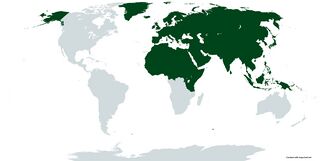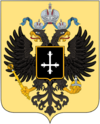Greater Gothic Empire: Difference between revisions
VickyPenny (talk | contribs) (Another second edition.) |
VickyPenny (talk | contribs) mNo edit summary |
||
| Line 78: | Line 78: | ||
|calling_code = .22 | |calling_code = .22 | ||
}} | }} | ||
'''Gothica''', both officially and formally referred to as '''the Greater Gothic Empire''' (Latin: ''Magnum Imperium Gothicum'') and informally called '''Greater Gothica''', is an intercontinental sovereign state in the globe. With an area of around 85,990,652 km<sup>2</sup> (33,201,176 mi<sup>2</sup>), it is the largest country in the world by area, spanning around 75% of the Earth's inhabited land area, four continents, all 24 time zones, and borders five sovereign countries. The Atlantic, Pacific, Arctic and Indian Oceans served as Gothica's maritime borders, while in Africa south of the Equator it borders the Kongo Clique and the Azanian Clique. It has running border disputes with the Trans-Atlantic Commonwealth in its Pacific Northwest holdings due to the annexation of the currently-defunct states of Cascadia and the Columbian Commonwealth, which posed a potential threat to Trans-Atlantic stability and still continues on to this day. Around 57.602 trillion subjects live in the Empire's 800 districts, which makes Gothica the most populous country in the world. Its capital and largest mega-city is World Capital | '''Gothica''', both officially and formally referred to as '''the Greater Gothic Empire''' (Latin: ''Magnum Imperium Gothicum'') and informally called '''Greater Gothica''', is an intercontinental sovereign state in the globe. With an area of around 85,990,652 km<sup>2</sup> (33,201,176 mi<sup>2</sup>), it is the largest country in the world by area, spanning around 75% of the Earth's inhabited land area, four continents, all 24 time zones, and borders five sovereign countries. The Atlantic, Pacific, Arctic and Indian Oceans served as Gothica's maritime borders, while in Africa south of the Equator it borders the Kongo Clique and the Azanian Clique. It has running border disputes with the Trans-Atlantic Commonwealth in its Pacific Northwest holdings due to the annexation of the currently-defunct states of Cascadia and the Columbian Commonwealth, which posed a potential threat to Trans-Atlantic stability and still continues on to this day. Around 57.602 trillion subjects live in the Empire's 800 districts, which makes Gothica the most populous country in the world. Its capital and largest mega-city is World Capital Gothica; other major urban areas include Ahmagards, Árheimar, Draculsburg, Gobbellin, Kaisergard, Katosgard, Mikilgard, Saint Putinsburg, Sigvaldsburg, Stahlgard, Unterburg, Vlachensgard, Walpurgisgard, among others. | ||
<br> | |||
<br> | |||
Human remnants, survivors of the massive thermonuclear outburst in the third decade of M2, re-emerged after resettling themselves in nearly post-contaminated soil following their confrontation with the wasteland environment. These settlements, followed by a slow and steady reconstruction of what was left of human civilization following the great ordeal, were often met with attacks from wasteland peoples, among them being the tribes that later make up the Goths that emerged as a significant people since the arrival of the semi-mythical Queen Basina (ca. 2726 to 4016?) and are to persist to this day (having been obviously confused with either the [https://www.history.com/topics/ancient-rome/goths-and-visigoths ancient Germanic tribe] or the [http://www.whatisgoth.com/ late 20th century post-punk music subculture and its later derivatives/types, as the latter is wholly more compatible with the post-apocalyptic peoples]). | |||
<br> | |||
<br> | |||
One of the post-thermonuclear wasteland states to arise in early M3 as of the era of the Radioactive Ice Age was a loose confederation of Gothic kingdoms under the nominal suzerainty of Great Oium, followed by several other states that developed across the Old World. Shifting from neo-paganism since High King Ottokar I, Great Oium in 3616 embraced Heterodoxy when High King Valamir I, the Great, converted from neo-paganism in response to a threat from the primitives whom he forcibly subdued and denounced 'greykin' witches as a cause of internal division. At an unknown time it has seen a revival especially of Gothic culture and aesthetic derived from the subculture, starting with the re-emergence of types such as Fairy Goth, Medieval Goth, and Tribal Goth, among others, and a wide interest in music and the arts, thus beginning the synthesis of pre- and post-apocalyptic wasteland dark alternative scene cultures that defined 'Gothic' culture for the next millennia. Since M4, Great Oium disintegrated into smaller states, shortly prior to the Neo-Proto-Finngolian and Daehwan invasions during the hazardous Great Radioactive Winter of 207.M4 - 885.M5, until it was finally reunified by the Kingdom of Eisenheim in late M5. By M100 onwards, the country had tremendously expanded through wasteland reclamation, conquest and annexation to become the present-day Empire, stretching across the entire Eastern Hemisphere from one end of the Trans-Atlantic Commonwealth on the West to the other one the east. By the start of Pax Gothica, the Empire had grown to include all Eurasia but not limited to most of Africa north of the Equator, Greenland, several islands in the Pacific, and the Pacific Northwest. The Empire played a very decisive role in the Great Interhemispheric War, and emerged victorious as a leading dominant superpower and rival to both the Trans-Atlantic Commonwealth and the Pan-Oceanic Union since the beginning of the Cold War. The eras preceding that of the Two Sisters saw the most significant technological breakthroughs of the unbelievably distant future millennia ever imagined, such as enhanced post-picotechnology and the Webway, and also saw the settlement and terraformation of Mars by the Empire. Since the reign of Empress Victoria I, the Empire spontaneously embarked on a grand-scale reconstruction program, part of her vision for its future after the Second Pax Gothica, starting with the renewal of Necropolis into a supra-massive ecumenopolis and the construction of a multidirectional city axis between the Pacific and Atlantic Oceans. | |||
Revision as of 06:54, 22 January 2021
Greater Gothic Empire Magnum Gothicum Imperium (Latin) | |
|---|---|
| Motto: Je Dio ni Fidas (Esperanto) "In God We Trust" | |
 | |
| Capital and largest city | World Capital Gothica — New Rome |
| Official languages | Classical Latin English |
| Recognised national languages | Russian German French Italian |
| Demonym(s) | Gothic |
| Government | Unitary theocratic totalitarian universal absolute monarchy |
• Empress | Victoria II |
• Imperial Chancellor | Richard von Nachtschatten |
• Chief of the Chamber of Magisters | Nero von Schadenfreude |
• Chief of the Chamber of Ministers | Alexander von Polnareff |
• Chief of the Chamber of Advisors | Libitina Jezebel Bartley-Wolff |
• Procurator of the Most Holy Synod | Metropolitan Gregory XXVIII |
| Formation | |
• Basinings founded | 4616 |
• Great Oium | 4818 |
• Crown of Eisenheim | 5018 |
• Old Dominion | 5135 |
• Empire formed | 22 May 6420 |
• Current governing charter | 19 October 11610 |
• Last polity admitted | 19 October 11610 |
• Last amendments | 7 April 12141 |
| Area | |
• Total | 85,990,652 km2 (33,201,176 sq mi) |
| Population | |
• Estimate | 7,623,403,011 |
| HDI | 0.312 low |
| Currency | Gothic mark (ℳ) GTM |
| Time zone | UTC —7 TO —4 |
| Date format | DD—MMM—YYY.MYYY |
| Driving side | left |
| Calling code | .22 |
| Internet TLD | .gth .gff |
Gothica, both officially and formally referred to as the Greater Gothic Empire (Latin: Magnum Imperium Gothicum) and informally called Greater Gothica, is an intercontinental sovereign state in the globe. With an area of around 85,990,652 km2 (33,201,176 mi2), it is the largest country in the world by area, spanning around 75% of the Earth's inhabited land area, four continents, all 24 time zones, and borders five sovereign countries. The Atlantic, Pacific, Arctic and Indian Oceans served as Gothica's maritime borders, while in Africa south of the Equator it borders the Kongo Clique and the Azanian Clique. It has running border disputes with the Trans-Atlantic Commonwealth in its Pacific Northwest holdings due to the annexation of the currently-defunct states of Cascadia and the Columbian Commonwealth, which posed a potential threat to Trans-Atlantic stability and still continues on to this day. Around 57.602 trillion subjects live in the Empire's 800 districts, which makes Gothica the most populous country in the world. Its capital and largest mega-city is World Capital Gothica; other major urban areas include Ahmagards, Árheimar, Draculsburg, Gobbellin, Kaisergard, Katosgard, Mikilgard, Saint Putinsburg, Sigvaldsburg, Stahlgard, Unterburg, Vlachensgard, Walpurgisgard, among others.
Human remnants, survivors of the massive thermonuclear outburst in the third decade of M2, re-emerged after resettling themselves in nearly post-contaminated soil following their confrontation with the wasteland environment. These settlements, followed by a slow and steady reconstruction of what was left of human civilization following the great ordeal, were often met with attacks from wasteland peoples, among them being the tribes that later make up the Goths that emerged as a significant people since the arrival of the semi-mythical Queen Basina (ca. 2726 to 4016?) and are to persist to this day (having been obviously confused with either the ancient Germanic tribe or the late 20th century post-punk music subculture and its later derivatives/types, as the latter is wholly more compatible with the post-apocalyptic peoples).
One of the post-thermonuclear wasteland states to arise in early M3 as of the era of the Radioactive Ice Age was a loose confederation of Gothic kingdoms under the nominal suzerainty of Great Oium, followed by several other states that developed across the Old World. Shifting from neo-paganism since High King Ottokar I, Great Oium in 3616 embraced Heterodoxy when High King Valamir I, the Great, converted from neo-paganism in response to a threat from the primitives whom he forcibly subdued and denounced 'greykin' witches as a cause of internal division. At an unknown time it has seen a revival especially of Gothic culture and aesthetic derived from the subculture, starting with the re-emergence of types such as Fairy Goth, Medieval Goth, and Tribal Goth, among others, and a wide interest in music and the arts, thus beginning the synthesis of pre- and post-apocalyptic wasteland dark alternative scene cultures that defined 'Gothic' culture for the next millennia. Since M4, Great Oium disintegrated into smaller states, shortly prior to the Neo-Proto-Finngolian and Daehwan invasions during the hazardous Great Radioactive Winter of 207.M4 - 885.M5, until it was finally reunified by the Kingdom of Eisenheim in late M5. By M100 onwards, the country had tremendously expanded through wasteland reclamation, conquest and annexation to become the present-day Empire, stretching across the entire Eastern Hemisphere from one end of the Trans-Atlantic Commonwealth on the West to the other one the east. By the start of Pax Gothica, the Empire had grown to include all Eurasia but not limited to most of Africa north of the Equator, Greenland, several islands in the Pacific, and the Pacific Northwest. The Empire played a very decisive role in the Great Interhemispheric War, and emerged victorious as a leading dominant superpower and rival to both the Trans-Atlantic Commonwealth and the Pan-Oceanic Union since the beginning of the Cold War. The eras preceding that of the Two Sisters saw the most significant technological breakthroughs of the unbelievably distant future millennia ever imagined, such as enhanced post-picotechnology and the Webway, and also saw the settlement and terraformation of Mars by the Empire. Since the reign of Empress Victoria I, the Empire spontaneously embarked on a grand-scale reconstruction program, part of her vision for its future after the Second Pax Gothica, starting with the renewal of Necropolis into a supra-massive ecumenopolis and the construction of a multidirectional city axis between the Pacific and Atlantic Oceans.

